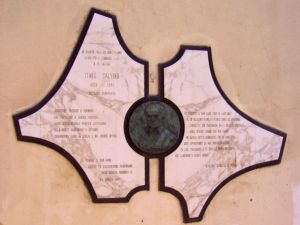Writer and a Partisan
Its History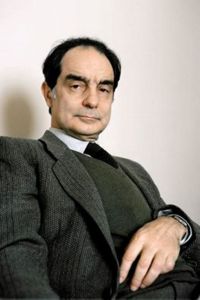 He was born in Santiago de las Vegas, near Havana, on 15 October 1923 from the Sanremo agronomist Mario and the scientist Giuliana Eva Mameli from Sassari.
He was born in Santiago de las Vegas, near Havana, on 15 October 1923 from the Sanremo agronomist Mario and the scientist Giuliana Eva Mameli from Sassari.
« I am Ligurian, my mother is Sardinian: I have the laconicity of many Ligurians and the mutism of Sardinians, I am the crossroads of two silent races », the 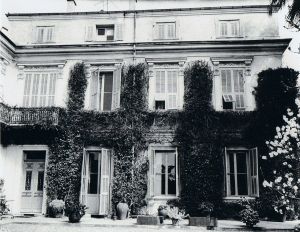 writer would have confessed ("L'occhio e il silenzio" [interview, 1983]; then in "Sono nato in America...", 2012, p. 553), which had no memories of Cuba: his parents already returned to San Remo in the autumn of 1925 and settled in Villa Meridiana, a building in a dominant position over the city, introducing exotic plants such as avocado, papaya, guayaba, pink grapefruit, and managing the ancestral countryside of San Giovanni.
writer would have confessed ("L'occhio e il silenzio" [interview, 1983]; then in "Sono nato in America...", 2012, p. 553), which had no memories of Cuba: his parents already returned to San Remo in the autumn of 1925 and settled in Villa Meridiana, a building in a dominant position over the city, introducing exotic plants such as avocado, papaya, guayaba, pink grapefruit, and managing the ancestral countryside of San Giovanni.
His father had been appointed director of the experimental floriculture station 'Orazio Raimondo' and, following the bankruptcy of Banca Garibaldi, made the park of his villa available for the continuation of his institute's research and teaching activities.
They were responsible for the transformation of Sanremo into the "city of flowers". Italo was destined to be the only man of letters in a family of scientists: as such he always considered himself, not entirely jokingly, the 'black sheep' of his lineage.
In 1927 he was born in Sanremo Floriano, Italo's only brother.
Calvino's parents, who came from families of republican and Mazzinian tradition, were anti-monarchical and anticlerical. More intransigent appeared, in the eyes of his son Italo, « the unadorned anti-fascist or pre-fascist rigour, impersonated by his mother's moralistic laic scientific humanitarian anti-bellicist zoophile moralistic severity » (see Autobiografia politica 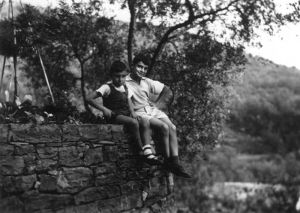 giovanile [1960]; in Saggi, 1995, II, p. 2740). The Calvin brothers did not receive religious education.
giovanile [1960]; in Saggi, 1995, II, p. 2740). The Calvin brothers did not receive religious education.
Italo, who attended nursery school at St. George College in 1927, and later, between 1929 and 1933, the Valdensian Schools in Via Roma, grew up with the precocious awareness of a difference from his peers and with the imperative to live up to this nonconformity. also becoming a balilla in the last years of primary schools.
In 1934, having passed the entrance exam, he enrolled at the Liceo-Ginnasio "G.D. Cassini", where he obtained his high school diploma in 1941.
He had the future founder of the newspaper, "La Repubblica" Eugenio Scalfari, as a fellow student, with whom, during his university years, he intertwined a dense intellectual-goliardic correspondence.
He then enrolled in the Faculty of Agriculture at the University of Turin, passing four exams in the first year.
In January 1943 he then moved to the Faculty of Agriculture and Forestry of the University of Florence, where he passed three exams.
After the 8th September 1943, reluctant to use the lever of the Republic of Salò and spent a few months in hiding until he heard the news of the death in combat of the young communist doctor Felice Cascione, decided to join the organisation of the PCI by participating in the Resistance in the Maritime Alps under the 2nd Garibaldi "F. Cascione" Assault Division.
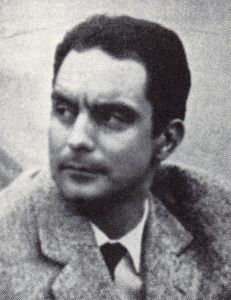
After completing his partisan experience, in September 1945 he enrolled in the third year of the Faculty of Letters at the University of Turin, where he moved permanently.
As activist of the PCI in the province of Imperia, he wrote in various local periodicals including "La Voce della Democrazia" (organ of the CLN of Sanremo), "La nostra lotta" (organ of the Matuziana section of the PCI) and "Il Garibaldino" (organ of the "Felice Cascione" Division).
In the first post-war period he also became a friend of Cesare Pavese and began to collaborate with the magazine "Il Politecnico" by Elio Vittorini.
In 1946 he began to gravitate around the Einaudi publishing house in Turin, selling books on instalments and simultaneously publishing articles on "Unità".
In 1947 his first novel was published at Einaudi: « Il sentiero dei nidi di ragno », set in the far west of Liguria during the partisan war. He worked in the press and publicity office of Einaudi, and forged ties of friendship not only with men of letters like Pavese, Vittorini and Natalia Ginzburg, but also with historians such as Delio Cantimori and Franco Venturi and philosophers, including Norberto Bobbio and Felice Balbo.
In 1948 he temporarily left Einaudi to work on the Turin edition of "Unità", where he edited the third page and at the same time collaborated on the communist weekly "Rinascita".
The following year the collection of short stories « Ultimo viene il corvo » was published.
On 1 January 1950 he was hired by Einaudi as permanent editor, press officer and literary director of the new "Piccola Biblioteca Scientifico-Letteraria".
On 27 August he was particularly struck by the suicide of Cesare Pavese, his fraternal friend and on whom he had planned to publish a collection of writings and various interventions.
Between October and November 1951, he made a trip to the Soviet Union, from which he drew the diary "Italo Calvino's travel notebook to the USSR", published in the "Unità" of February-March of the following year, and from which he would have won the Saint Vincent's Prize. In 1952 it was published in the Einaudiana series "I gettoni", directed by Vittorini, the fantastic novel « II visconte dimezzato », which was a great success and aroused a lot of interest. However, there are conflicting reactions in the left-wing critics.
In May 1952 the first issue of the "Notiziario Einaudi" was also published, of which Calvino formally became editor-in-chief from No. 7 of the same year.
Still in 1952 he also published the story « La formica argentina » in the Roman literary magazine "Botteghe Oscure".
In 1953, on the other hand, in the Roman magazine "Nuovi Argomenti", the story « Avanguardisti a Mentone » was published, while the following year, the "Gettoni" would have published « L'entrata in guerra ».
On 1 January 1955 he became an executive of Einaudi, maintaining this position until 30 June 1961, after which he would move on to the position of editorial consultant.
In 1956 the collection of « Fiabe italiane » appeared in the Einaudi series "I Millenni", which he took care of with the collaboration of the ethnologist Giuseppe Cocchiara.
On the occasion of the events in Hungary and of the XX Congress of the PCUS, he took an extremely critical position towards the line adopted by the National Directorate of the PCI, dissociating in particular from the interpretation put forward by the "Unità" regarding the events in Hungary.
After Antonio Giolitti abandoned the PCI, on 1 August 1957 he resigned from the party in a letter to the Federal Committee of Turin, of which he was a member, published on 7 August in "Unità".
In the same year, « ll barone rampante » was also published, again by Einaudi, and the story « La speculazione edilizia » on issue XX in "Botteghe Oscure". In 1958 he published instead in "Nuovi Argomenti" « La nuvola di smog », which was followed in the same year « il grande volume antologico dei Racconti », which would be awarded the year after the Bagutta prize.
Among his main works: the novel « Il Visconte Dimezzato » (1952); « Il Barone Rampante » (1957); « Il Cavaliere Inesistente » (1959) which Calvino would later collect in the trilogy I Nostri Antenati (Our Ancestors), published in 1960 with an important introduction; « Le Città Invisibili » (1972); « Sotto il Sole Giaguaro » (1986). In 1959 he also became editor of the magazine "Il Menabò" together with Elio Vittorini (1959-66).
In September the mimicry story Alletgfiop, set to music by Luciano Berio, was staged at the Fenice in Venice.
In November he left for the United States, where he stayed for six months, four of which he spent in New York. In April 1962, while his fame was becoming more and more consolidated, he met in Paris the Argentine translator Esther Judith Singer, called Chichita, who she married in Havana in 1963, visiting her birthplace and the house where her parents lived in Cuba, where she also had a personal meeting with Ernesto. "Che" Guevara. After the summer he moved with his wife to Rome, from where he moved every fortnight to Turin for meetings and correspondence.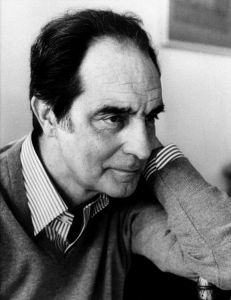
In 1963 he began to follow with interest the developments of the so-called neo-avant-garde movement, represented in particular by Group 63. In the same year he published in the Einaudiana series "Libri per ragazzi" the collection « Marcovaldo ovvero Le stagioni in città », illustrated by twenty-three plates by Sergio Tofano.
Also in '63 came out « La giornata d’uno scrutatore » and the edition of Building speculation in autonomous volume.
In 1965 his daughter Giovanna was born in Rome and in the same year he published « Le Cosmicomiche ». On 12 February 1966 he was deeply struck by the death of Elio Vittorini, to whom he had deep human ties. as well as professional.
In July 1967 he moved with his family to Paris, where he would stay until 1980. In the French capital, he was acquainted with the writer Raymond Queneau, who was to introduce him to others members of the Ouvrir de littérature potentielle, including Georges Perec, Francois Le Lionnais, Jacques Roubaud and Paul Fournel.
In '68 also came out the collection of short stories Li con gero, to which the Viareggio prize would be awarded, but which Calvino would refuse in open polemic with the "official" literary institutions.
In 1970 the book of short stories « Gli amori difficili », was published, while from the re-elaboration of the material of a series of radio broadcasts, a selection of passages from the Ariostesque poem, published in the following years, was published in the same year under the title « Orlando furioso di Ludovico Ariosto raccontato da Italo Calvino ». In 1972 the « Le città invisibili »,, followed the following year by the « Castello dei destini incrociati ».
In 1974 he began to write in the "Corriere della Sera" stories, travel reports and a dense series of interventions on the political and social reality of the country.
In 1976 he gave lectures at various Universities in the United States and received the Staatpreis in Vienna. Three years later he published the novel « Se una notte d’inverno un viaggiatore » (If a traveller on a winter night), while at the same time starting a strong collaboration with the daily newspaper La Repubblica, directed by the his old high school friend Eugenio Scalfari.
In 1980 he moved to Rome in Piazza Campo Marzio and collected in the volume « Una pietra sopra » speeches on literature and society, the most significant part of his essays since 1955.
In 1981 he came to awarded the Legion of Honour and presided over the jury of the XXIX Venice International Film Festival. 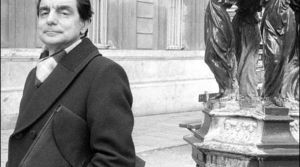 In 1983 the novel Lalomar was published at Einaudi, while Calvino was nominated "directeur d'études" for a month at the Ecole des Hautes Studes in Paris.
In 1983 the novel Lalomar was published at Einaudi, while Calvino was nominated "directeur d'études" for a month at the Ecole des Hautes Studes in Paris.
In 1984, following the serious crisis at the Einaudi publishing house, he decided to accept the offer of the Milanese publisher Garzanti, where Colletone di sabbia and Cosmicomiche old and new would be published.
In the summer of 1985 he worked on a cycle of six lectures which he was to give at Harvard University in the academic year 1985-86, and which would be published in the posthumous work Legioni americane.
Six proposals for the next millennium, published in 1988.
Struck by a stroke on 6 September in Castiglione della Pescaia, he was admitted to the Santa Maria della Scala hospital in Siena, where he died after bleeding cerebral in the night between 18 and 19 September 1985.
After his death several posthumous works were to come out, including « Sotto il sole giaguaro » (1988), « Sulla fiaba » (1988), « La strada di San Giovanni » (1990), « Perché leggere i classici » (1991), « Prima che tu dica ‘pronto’’ » (1993) ed Premita a Parigi (1994) and the texts of 5 of the six conferences that C. was supposed to give at Harvard Univ. in 1985-86: American Lessons. Six proposals for the next millennium (1988).
In 2012 the volume « Sono nato in America » (I was born in America) was published by L. Baranelli and M. Barenghi. Interviews 1951-85.
On the occasion of the Liberation Day on 25 April 1988, the Municipality of Sanremo had a memorial plaque placed in his memory on the facade of the building that had hosted the Liceo "Cassini" in Piazza Nota.
On 13 October 1963 Calvino was also nominated "Meritorious Citizen" of Sanremo by the Municipal Administration for his merits in the literary and cultural field.
His humanistic culture
Calvino's first aesthetic education did not take place in books, but in the comics of the Corriere dei piccoli, of which, as precocious as it was unconscious structuralist, he broke down, recomposed and contaminated the plots.
During his adolescence he opposed Fascism not a defined antagonistic ideology but a malevolent impatience with his solemn and ridiculous style. The other place where he found refuge was the cinema, which occupied most of his afternoons, while at home he devoted himself to a different visual passion, reading the humorous weeklies of those years and cultivating a talent for drawing: under the pseudonym Jago some of his cartoons found a place in the Bertoldo's "Il cestino" column.
Calvino's first readings therefore rested on a primary sediment of images, drawn or projected. Perhaps this explains the germination from an obsessive image of many of his stories to come: a man cut in two, a boy climbing a tree, an empty armour going around the world.
The pillars of Calvin's youth library are four nouns - adventure, energy, exoticism, mystery - that describe a literary education arched between 6 and 23 years of age, between Pinocchio, "the book that I already knew chapter by chapter before learning to read" (« Il fantastico nella letteratura italiana » [1984]; in Saggi, 1995, II, p. 1682) and America by Kafka, "the novel" par excellence in 20th century world literature and perhaps not only in that" (Interview by Maria Corti [1985], ibid, p. 2921).
One of the most significant narrators of the Italian twentieth century, in the literary constellation drawn from his numerous works, different vocations and themes are fully hybridized, from the neo-realistic imprint of the initial writings to the allegorical and fairy-tale one of the most mature production. In his prose, where the highest suggestions of the contemporary literary panorama are welcomed and filtered and where the writer reveals himself to be an unscrupulous experimenter of languages and genres, the lucidity of analytical description is constantly counterpointed by lyricism and irony, substantiated by a deep and disenchanted reflection on the ultimate meaning of human existence.
Since his first novel, Il sentiero dei nidi di ragno (1947), inspired by the Resistance, and from the tales of Ultimo viene il corvo (1949), it is evident that the tendency towards realism and the fantastic are complementary in him, nourished by the same exciting repertoire of adventurous readings and rigorously played around the generative core of pure narrativity.
In this way, in the alternation of the realistic register [the overall collection « I racconti », 1958, or the short novel « La giornata di uno scrutatore », (1963) and the fantastical one, the already mentioned Il visconte dimezzato, Il barone rampante, Il cavaliere inesistente], one must recognise the same lucid experimental vocation, capable of regaining to literature the ancient sense of total experience and the frontier of knowledge, through the assumption of scientific themes and the perception of their very high fantastical tenor.
It has therefore been possible to speak of science fiction with regard to the amusing surveys attempted with Le cosmicomiche (1965) and Ti con zero (1967), but no label that does not contemplate comparison with the most advanced hypotheses of mediation between scientific and literary culture can give an account of the writer's subsequent research (the already mentioned Le città invisibili; Il castello dei destini incrociati, 1973; Se una notte d'inverno un viaggiatore, 1979)), for which the work of the Argentinean J. L. Borges constitutes a privileged point of reference and not a model, and from which an exemplary non-fiction production is now inseparable (Una pietra sopra, 1980; Collezione di sabbia, 1984).
A further phase of the same research is represented by Palomar (1983), in which the writer's more open scepticism tends to translate into a sort of unreliable system, while the narration is broken down into its elementary functions, represented by the 27 short texts that weave a virtuosistic organic novel.
Calvino also edited a collection of Italian Fairy Tales "transcribed in language by the various dialects" (1956).
(sources: elaboration from texts taken from Enciclopedia Treccani, Andrea Gandolfo; images from the Web and personal archive).





